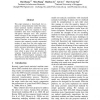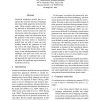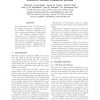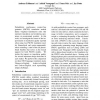106
click to vote
COLING
2010
14 years 7 months ago
2010
Previous methods on improving translation quality by employing multiple SMT models usually carry out as a secondpass decision procedure on hypotheses from multiple systems using e...
103
click to vote
ACL
2009
14 years 10 months ago
2009
Current SMT systems usually decode with single translation models and cannot benefit from the strengths of other models in decoding phase. We instead propose joint decoding, a met...
106
click to vote
ACL
2009
14 years 10 months ago
2009
This paper proposes a forest-based tree sequence to string translation model for syntaxbased statistical machine translation, which automatically learns tree sequence to string tr...
93
Voted
ACL
2010
14 years 10 months ago
2010
Statistical translation models that try to capture the recursive structure of language have been widely adopted over the last few years. These models make use of varying amounts o...
96
Voted
ICASSP
2010
IEEE
14 years 11 months ago
2010
IEEE
In recent work, we proposed an alternative to parallel text as translation model (TM) training data: audio recordings of parallel speech (pSp), as it occurs in any communication s...
102
click to vote
CORR
1998
Springer
15 years 3 days ago
1998
Springer
A model of co-occurrence in bitext is a boolean predicate that indicates whether a given pair of word tokens co-occur in corresponding regions of the bitext space. Co-occurrence i...
100
Voted
ACL
1997
15 years 1 months ago
1997
Many multilingual NLP applications need to translate words between different languages, but cannot afford the computational expense of inducing or applying a full translation mode...
112
Voted
NAACL
2007
15 years 1 months ago
2007
In the framework of the Tc-Star project, we analyze and propose a combination of two Statistical Machine Translation systems: a phrase-based and an N-gram-based one. The exhaustiv...
EMNLP
2007
15 years 1 months ago
2007
We present an extension of phrase-based statistical machine translation models that enables the straight-forward integration of additional annotation at the word-level — may it ...
104
Voted
COLING
2008
15 years 1 months ago
2008
Probabilistic synchronous context-free grammar (PSCFG) translation models define weighted transduction rules that represent translation and reordering operations via nonterminal s...




